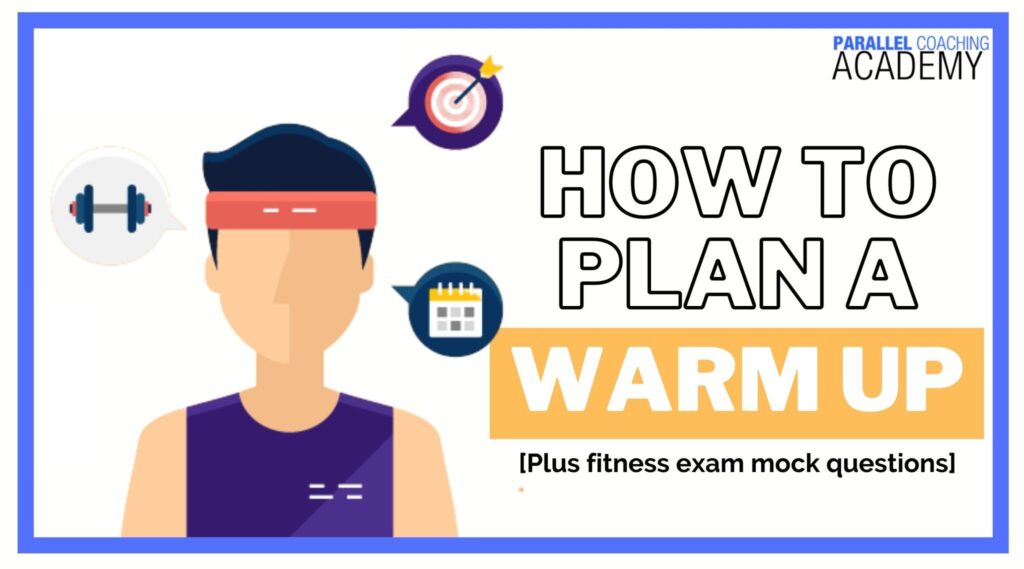Today’s blog will explore how to plan a warm-up that is safe, effective and relevant to your client’s main session. This is for you if you are a trainee/newly qualified FITPRO, or confused and overwhelmed about planning client fitness sessions.
I’m going to share an acronym that will offer simplicity and structure to your client warm-ups. You can then apply this to every client session, making small changes relevant to the client and the session ahead.
Watch the 8-minute video to reveal how to plan a warm-up, then test your knowledge with three mock questions.
Watch: How To Plan A Warm-Up
What is a Warm-Up?
A warm-up prepares the mind and body for the session that follows. It prepares the client to perform optimally and ensures that they are safe to participate at the intensity required in the main session.
Nearly all warm-ups can follow a generic structure, much like a cookie-cutter. It gives you structure and a guide to plan multiple sessions in a quick way. However, there is also space for individuality …
The cookie can be decorated, have icing, chocolate chips, sprinkles etc…
The individuality in your warm-up includes:
- Does your client need a longer pulse raise for their asthma?
- Or maybe they have tight hip flexors and you add an extra hip flexor stretch?
- Maybe they need an extra mobility exercise to ease their sore back or arthritis?
These individualities come after you have the initial generic structure.
We use the acronym MARS to remember the order of a safe and effective warm-up
MARS is a warm planet, so we will use this as an acronym to add structure to a generic warm-up
M = Mobility exercises
A series of fluid movements that gradually increase synovial fluid lubrication on major joints
You’d typically choose at least three exercises, one for hips, one for spine and one for shoulders. However, some clients will need to mobilise specific joints, which will determine how many you include.
Typically perform these gentle exercises for approx 5-10 repetitions, in a fluid and controlled motion.
A = Activation exercises
This is a chance to activate the muscles, posture, and core before increasing intensity. You can focus on the muscles that will be targeted in the session ahead, or you can consider which muscles are “weak” based on your consultation and squat assessment.
Typically you’d perform 5-10 reps of each exercise at an easy intensity, as a way of gradually loading the target muscles.
R = Raise Pulse
This is a gradual increase of heart rate to RPE 4 or 5 (out of 10) using a cardiovascular exercise. Usually, about 5 mins long, but might be longer if the client requires an extended warm-up.
You could use a piece of CV equipment like a treadmill or bike, or you could use bodyweight exercises or even gameplay in a group setting.
The idea is to raise the temperature of the body and prepare the energy systems ready for the session ahead.
S = Stretch
This is where the muscles can achieve full range of motion (ROM) before the main session, to avoid injury and strains. You could select dynamic stretches that gradually progress ROM whilst keeping the body temperature high, but these require more balance and coordination.
If the client has poor coordination and balance you may choose static maintenance stretches to stretch the whole body.
Keep it simple and structured
Avoid the temptation to overcomplicate your session plans and warm-ups, a simple and structured plan is often more effective than an overcomplicated mix-match of exercises.
Our FIT-Progressions online programme details session structure, warm-ups, cool downs and how to plan for each component of fitness in order to get the best client results.
Plus you learn how to piece it all together for your L3 Personal Trainer Case study and accelerate your client journey so you can be an outstanding FITPRO.
>>>> Join us for FIT-Progressions here

Become a knowledgeable and confident FITPRO, with a clear strategy to get results with your clients every time.
There’s no more self-doubt. There’s no more guessing what to plan or how to get client results. FIT-Progressions has 8 modules and 18 video tutorials that guide you through every stage of your Level 3 Personal Trainer case study, and how to work with clients effectively.
This is for you if you’re…
- struggling to complete your coursework for PT, Yoga, or Pilates
- a newly qualified FITPRO that feels stuck or overwhelmed
- unsure where to start when planning a client session
- worrying about applying your course knowledge with a real client
- doubting you could get results and lack structure to client packages
- anxious and confused about how to get found and get busy
Click the link to find out more and join us:
https://courses.parallelcoaching.co.uk/products/fit-progressions/
Test your knowledge with today’s planning mock questions:
[NOTE: The answers are below the 3rd questions]
Q1: What is the acronym used to structure a generic warm-up?
A. SATURN
B. MARS
C. VENUS
D. PLUTO
Q2: What is the name given to the lubricating fluid found inside a joint?
A. Synovial fluid
B. Cartilaginous fluid
C. Joint oil
D. A tendon
Q3: What factors would influence the stretches chosen for a warm-up?
A. Client coordination and balance
B. Worries that the client is bored
C. The newest gym equipment
D. The FITPROs personal preference
Answers to the mock questions are :
Question 1= B, Question 2 = A, Question 3 = A
If you want more mock questions like this, then you can download more Free Mock Questions: DOWNLOAD NOW
Dedicated to More
Hayley “How To Plan A Warm-Up” Bergman
Parallel Coaching
P.S. You can also find us on the following platforms:
Instagram: https://www.instagram.com/parallelcoaching
Facebook: https://www.facebook.com/ParallelCoaching
Twitter: https://twitter.com/ParallelCoach
YouTube: http://bit.ly/2F1Z1bs
Read more Planning blogs: HERE

